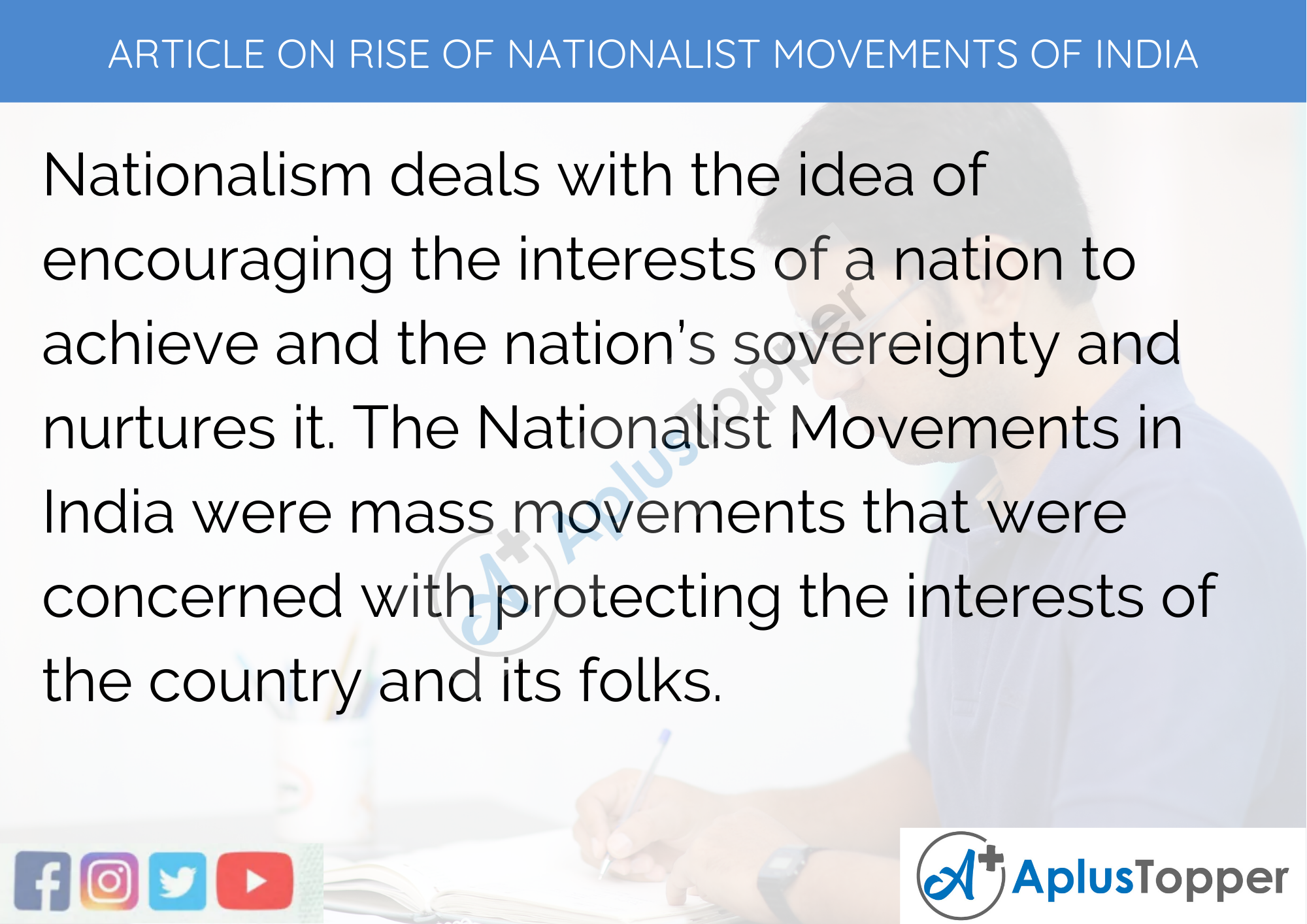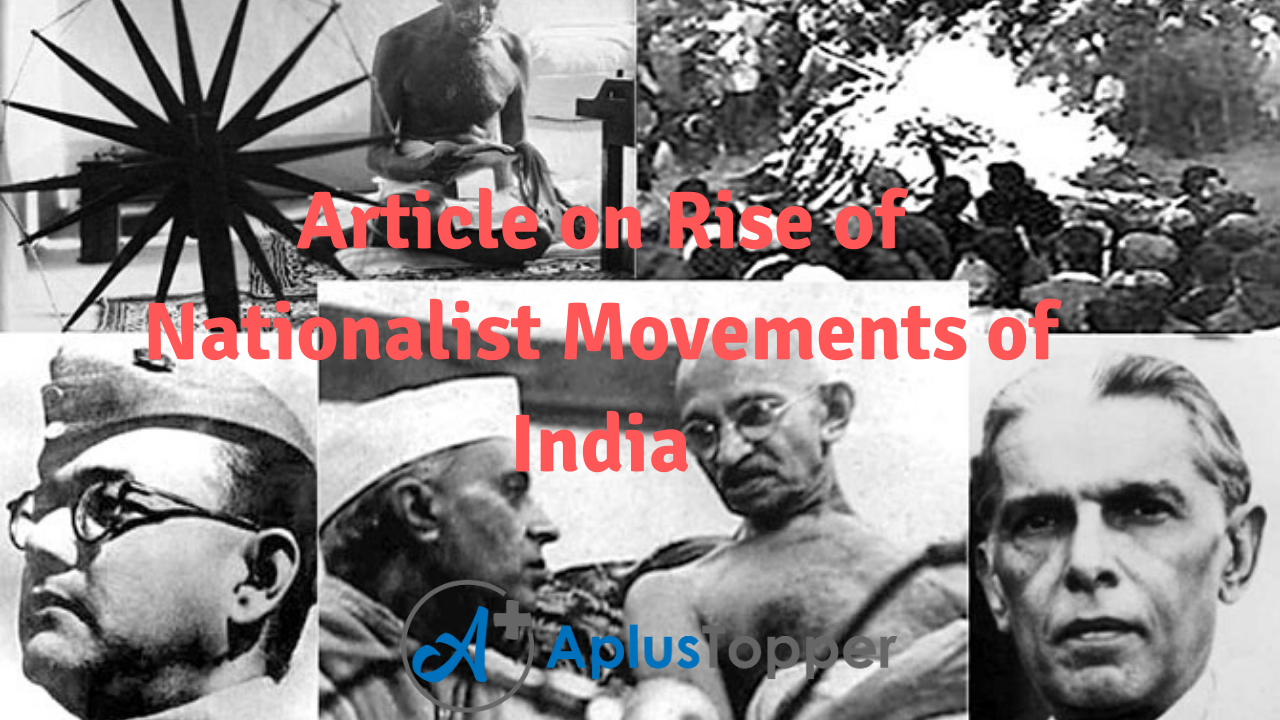Article On Rise Of Nationalist Movements Of India: Indian Nationalism is the feeling of devotion, love and pride towards our country. It was the Indian Nationalism which united our political dissidents to battle against the British rule.
The Salt March, Non-Cooperation Movement and Quit India movement by Mahatma Gandhi indicated an incredible type of patriotism and nationalism. The revolt of 1857 was a defining moment in the Independence battle which established the framework of opportunity from the British principle.
The nationalism had made India an integrated country despite tremendous religious and caste variations. It was nationalism which made our country self-dependent in politics, social and economic factors in the world, making the country a republic and a sovereign nation.
You can read more Article Writing about people, sports, technology many more.
Long And Short Articles On Rise Of Nationalist Movements Of India for Students and Children in English
The Rise of Nationalist Movements Of India is an essential part of the history of Independence of India, which should be known by every Indian citizen. Students who go to schools can get asked to write articles on the subject for their assignments and exams. The long article on rise of nationalist movements of India are useful to people studying in classes 7, 8, 9, and 10. On the other hand, the short article on rise of nationalist movements of India are standard among students of classes 1, 2, 3, 4, 5, and 6.

Long Article On Rise Of Nationalist Movements Of India In English 500 Words in English
Nationalism deals with the idea of encouraging the interests of a nation to achieve and the nation’s sovereignty and nurtures it. The Nationalist Movements in India were mass movements that were concerned with protecting the interests of the country and its folks. Nationalist Movements in India was not a sudden occurrence, but its commencement brought about a sense of patriotism among the Indians.
The growth of the Indian middle class along with its diverse political leaderships had a significant role to play in granting growth to India’s identity. People became more aware of the concept of national identity, which therefore contributed to the rise of nationalism in India.
On 28th December 1885, the Indian National Congress was founded which aimed at training the Indian youths in political agitations and to create a public opinion in India.
Indians were hostile towards Lord Curzon’s Partition of Bengal in 1905. A demonstration against the partition was held in Town Hall of Calcutta, which later spread to the entire country. The partition took place on 16th October 1905. This day was declared as a day of mourning throughout Bengal, along with hartals being taken place in Calcutta.
Songs written and composed by Rabindranath Tagore, Rajanikanta Sen, and Syed Abu Mohd, provided the Indians with a taste of nationalistic spirits. Rabindranath Tagore’s famous national song “Amar Shonar Bangla” was composed for the occasion of partition. “Bande Mataram” had become a theme song for the anti-partition movement. The Rakshabandhan ceremony was also carried out that marked a symbol of the unbreakable bond between the Hindus and Muslims belonging to the two parts of Bengal.
Among the movements, the Swadeshi Movement was the most successful since it encouraged the Indians to boycott British products and use Indian handmade products. Foreign clothes were burnt; shops were forced to shut down. This movement was successful in upgrading the economic condition of India.
Eminent leaders of this movement were Bal Gangadhar Tilak, Rabindranath Tagore, Bipin Chandra Pal, Lala Lajpat Rai, and Surendranath Banerjee. A significant feature of the Swadeshi Movement was the active participation of women. Women eagerly joined the movement and took part actively in processions and picketing of foreign shops selling cloth. Students also took part actively but were penalized later.
The Home Rule Movement was organised by Annie Besant and Bal Gangadhar Tilak which lasted for two years 1916-1918, demanding for self-government within the British occupied nation. This was looked up as an opportunity to gain independence from the British Raj.
The British occupied nation came under pressure due to Mahatma Gandhi’s non-violence movement. July 14th 1942 marks an important day in the Indian history; for this was the day the Indian National Congress demanded complete independence from British Raj. Their demands being unfulfilled would otherwise lead to extreme disobedience by the mass. On 8th August the Quit India Movement took place, marking the beginning of a civil disobedience movement by the Indians. Unable to achieve success, the Quit India Movement came to an end in 1943.
Short Article On Rise Of Nationalist Movements Of India 300 Words in English
Indian Nationalism is a renowned concept of Indian history for the struggle of the Indian Independence Movement which was fought against the rule of British. Indian nationalism was the instance of all the Indians irrespective of their diverse ethnic, religious and linguistic backgrounds.
Many emperors and governments have ruled India in the pages of history. This included rules of Indian kings, Muslim emperors and finally British Government.
The nationalist movements were organized as a movement led by the mass of Indians emphasizing and raising questions concerning the rights of an Indian citizen. This was a massive movement for the cause of Nationalism, but it wasn’t enough to win Independence for India. But it promoted the idea of Nationalism among every citizen of the country India.
The movements included the Salt March which was led by Mahatma Gandhi himself, walking a long distance from Sabarmati Ashram to Dandi, extracting salt from the seashore to refuse to pay high tax which was imposed on salt.
The Swadeshi Movement influenced the Indian people to stop using foreign products, and start using the handmade products which were made in India
Surendarnath Banerji, Rabindranath Tagore, Lala Lajpat Rai, Bal Gangadhar Tilak, Bipin Chandra Pal were some of the prominent leaders of Nationalist Movements in India.
Even though in their first movements, the citizen of India failed to achieve Independence, but they glorified the nationalist sentiment among the Indian population, which made everybody united.
On 14th July 1942, the National Congress of India made a resolution for complete Independence in the struggle of nationalism against British people. The Quit India Movement and the Civil Disobedience Movement, which was led by Mahatma Gandhi impacted a lot on the British Government. After all the struggle and movement, different success and failure, Indians finally paved their way to Independence.

10 Lines On The Rise Of Nationalist Movements Of India
- The nationalism is a feeling of having a place and responsibility of the individuals towards their Motherland.
- Nationalism is significant for uniting the individuals of India irrespective of religion and ethnicity.
- The Great Revolt of 1857, both aided in planting the seeds of nationalism in the Indians.
- Many political components added to the ascent of Indian Nationalism.
- Many social stigmas emerging from the harsh policies of the British Empire gave rise to a Nationalism.
- English, as a common communication language, assumed a significant job in mixing Nationalism.
- Communications, mainly through the print media, took Indian Nationalism to another level.
- Different methods of communication, giving ease of movement to Indian masses assumed an essential job in the ascent of Nationalism among Indians.
- Nationalism is the most significant element of United India.
- Nationalistic notions are at their most extreme during National celebrations.
FAQ’s on Article on Rise of Nationalist Movements of India
Question 1.
When was the Indian National Congress formed?
Answer:
December 1885.
Question 2.
The Partition of Bengal was announced by whom and when?
Answer:
Lord Curzon in 1905.
Question 3.
In India, the Home Rule Movement was started by whom, and it lasted how long?
Answer:
Annie Besant and Bal Gangadhar Tilak. It lasted between 1916-1918.
Question 4.
Why was the non-cooperation movement called off by Gandhiji?
Answer:
Twenty policemen were killed in chauri-chaura, causing Gandhiji to call-off the movement.
